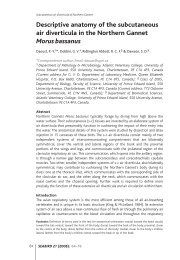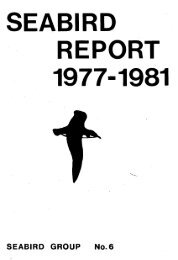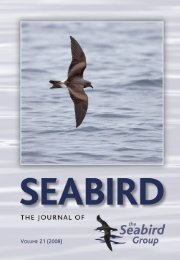Create successful ePaper yourself
Turn your PDF publications into a flip-book with our unique Google optimized e-Paper software.
2001 Return rates of Common Terns 185<br />
Consequently, hatching order and sibling number may be important<br />
factors during the first days in the life of a chick. But the number of chicks that<br />
can be reared successfully under the prevailing environmental conditions mainly<br />
depends on the quality of the parents. At fledging, possible effects of hatching<br />
order have been balanced by parental quality, and brood size has been adapted<br />
to the parental capacity for rearing chicks (see also Becker et al. 2000). <strong>The</strong> lack<br />
of influence of both hatching order and sibling number on post-fledging survival<br />
of Common Terns indicates that the quality of a pair that is reflected already in<br />
the number of fledglings, loses much of its importance after their young fledge.<br />
Probably post-fledging care is much less demanding than pre-fledging care<br />
because the fledglings accompany their parents to the feeding grounds within a<br />
few days after fledging (Nisbet 1976; own unpubl. data). Furthermore, parents<br />
are able to exploit additional feeding resources that are situated beyond the<br />
feeding range during the pre-fledging stage. Both factors might minimise the<br />
competition between siblings.<br />
ACKNOWLEDGEMENTS<br />
We are indebted to M. Wagener and H. Wendeln for their help in the field as well as with data<br />
management. Many thanks to many other voluntary fieldworkers. We thank H. Wendeln and the<br />
reviewers I.C.T. Nisbet and N. Ratcliffe for commenting on the manuscript. This study was<br />
supported by the Deutsche Forschungsgemeinschaft (Be 916/3 and 916/5).<br />
DE INVLOED VAN DE VOLGORDE VAN UITKOMEN EN UITVLIEGEN OP HET<br />
PERCENTAGE TERUGKERENDE JONGEN BIJ DE VISDIEF STER�A HIRU�DO<br />
Bij dit onderzoek werden uitgevlogen Visdieven die als hoopvolle broedvogels terugkeerden op de<br />
onderzoekskolonie in de Banter See (havengebied Wilhelmshaven, Duitsland), vergeleken met vogels<br />
die niet terugkeerden. Bij ieder legsel werden de jongen gemerkt en werd bepaald in welke volgorde<br />
de eieren uitkwamen. Vervolgens werd gekeken in welke volgorde de jongen de kolonie als<br />
vliegvlugge juvenielen verlieten. Er bleek geen enkel verband te bestaan tussen de volgorde van<br />
uitkomen en uitvliegen en de kans dat een dergelijk jong in de kolonie werd teruggezien. De<br />
gegevens suggereren dat gedurende de jongenzorg ná het uitvliegen van de jongen (rond de kolonie<br />
en onderweg naar de overwinteringsgebieden) de individuele verschillen in kwaliteit van de ouders<br />
een ondergeschikte rol spelen op de overlevingskansen van het jong.<br />
REFERENCES<br />
Becker P.H. 1996. Flußseeschwalben (Sterna hirundo) in Wilhelmshaven. Oldenb. Jahrbuch 96:<br />
263-296.<br />
Becker P.H. & Finck P. 1985. Witterung und Ernährungssituation als entscheidende Faktoren des<br />
Bruterfolgs der Flußseeschwalbe (Sterna hirundo). J. Ornithol. 126: 393-404.<br />
Becker P.H. & Wendeln H. 1997. A new application for transponders in population ecology of the<br />
Common Tern. Condor 99: 534-538.<br />
Becker P.H., Wendeln H.& González-Solís J. 2000. Population dynamics, recruitment, individual<br />
quality and reproductive strategies in Common Terns marked with transponders. Ardea: 89:<br />
241-252.








